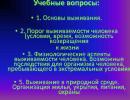Properties of living organisms (grade 5). Signs of living organisms The main levels of organization of wildlife: cellular, organismal, population-species, biogeocenotic
The earth is inhabited by diverse living beings, not similar to each other. Despite the different structure and special way of life, they are united by the properties of living organisms. These properties distinguish living matter (all living beings of the planet), from inanimate nature (mountains, rivers, stones).
Properties
The differences between living nature and inanimate matter are described in detail in the table of properties of a living organism.
|
sign |
Description |
|
Cell structure |
Living beings are made up of cells - the building blocks of life. It is the unit of all living things. Life is impossible outside the cell |
|
The energy needed to sustain life is extracted from food. Plants are autotrophs and use sunlight, carbon dioxide, water with minerals as food. The process of creating nutrients within the body using light is called photosynthesis. The rest of the creatures feed on ready-made substances, i.e. eat other creatures, and are called heterotrophs |
|
|
Metabolism |
The scientific name is metabolism. This is the process of extracting useful, nutritious, vital substances from food coming from the external environment. Complex substances break down into simpler ones, from which each cell forms the substances necessary for the body, and also extracts energy and heat. |
|
It is part of the metabolism. Organisms take in oxygen from the air and release carbon dioxide. Oxygen oxidizes, i.e. combines with other substances, and participates in complex biochemical reactions |
|
|
Organisms are constantly growing. In multicellular organisms, this occurs due to cell division. |
|
|
Irritability |
The ability to respond to manifestations of the external environment. For example, flowers close when there is a lack of sunlight, and a person withdraws his hand when in contact with a hot object. |
|
reproduction |
Organisms reproduce creatures similar to themselves. This is a complex process that can proceed in different ways depending on the complexity of the organization of the organism. For example, single-celled creatures divide, plants reproduce by seeds or parts of the body, for the reproduction of mammals, two individuals are needed - male and female. |
|
This natural process is the logical end of life. All living things, regardless of lifespan, die and decompose, giving food to other organisms. |

Rice. 1. Cellular structure of organisms.
Living organisms do not live apart from inanimate nature, but actively interact with it. Water and oxygen - belong to inanimate matter, but at the same time are vital substances for living organisms. The interaction of animate and inanimate nature through metabolism is called the circulation of substances.
Biodiversity
The general properties of living things are inherent in both unicellular organisms, consisting of only one cell, and complexly organized animals, such as humans. All biodiversity for ease of study subdivided into five kingdoms:
- viruses;
- bacteria;
- plants;
- mushrooms;
- animals.

Rice. 2. Kingdoms of wildlife.
Many scientists consider viruses to be inanimate nature. They are on the border of the transition of substances into a living form and have the properties of living and inanimate matter. For example, they are capable of reproduction, but they do not grow and do not feed.
Bacteria differ from other single-celled organisms (plants and animals) in the absence of a nucleus - the part of the cell in which hereditary information is stored. Such primitive organisms reproduce by division and have all the signs of life.
TOP 4 articleswho read along with this
Plants, fungi and animals are eukaryotes. Their cells have a well-formed nucleus. Plants differ from fungi in that they have leaves and are capable of photosynthesis. Mushrooms are not animals, because. have a special structure and are not capable of active movement.
The animal kingdom is very extensive and covers many creatures from unicellular protozoa (amoeba) to mammals (elephant, cat, squirrel), which include humans.

Rice. 3. Variety of animals.
All living organisms have the same chemical composition, because. are made up of the same elements. Carbon, oxygen, nitrogen, hydrogen are essential for life.
What have we learned?
From the 5th grade biology lesson, we learned about the basic properties of living matter, as well as about the diversity of life on Earth. The main signs of living things are reproduction, respiration, nutrition, growth. The basis of all living beings is the cell. All the diversity of wildlife is represented by five kingdoms - viruses, bacteria, plants, fungi, animals. Viruses are a transitional form from inanimate to living matter.
Topic quiz
Report Evaluation
Average rating: 4.8. Total ratings received: 1979.
When we talk about ot-li-chi-yah of living and non-living nature, it’s useful to imagine a stone and a cat or a dog-ba-ku. From-li-chia is, and they are obvious. How are they defined by science?
To especially-ben-no-stay of living she from-but-sits the following-du-u-u-ing-su-practical-ti-che-ski to all living or-ga-niz-mum pro-processes: pi-ta-nie, dy-ha- nie, you-de-le-ning, diversification, mobility, diversification, adaptability, growth and development.
Of course, a stone can be movable if it is thrown, it can multiply if it is broken, it can even grow if it has cr -has-become-a-che-nature and is on-going in a saturated co-left race (Fig. 1).
Rice. 1. Actions with a stone
To do this, you need an external influence, while the stone is unlikely to start to pi-t-to, to annoy and sigh from such injustice . In the especially-ben-no-ties of life-in-go and non-life-in-go on-ho-dyat from-ra-the-same-property of life-in-go, someone is already with nothing re-re-pu-ta-eat. What are these properties?
1. In or-ga-niz-maxes and their cells contain the same chi-mi-che-elements as in the bodies of inanimate nature. But in the cells of living beings there is also or-ga-no-che-things, someone-rye-lu-chi-whether such a name, because for the first time you were de-le-na from living beings, from or-ga-lower- mov. These are proteins, fats, carbohydrates and nuc-le-and-new acids. These substances give rise to uplifting structures (Fig. 2).
Rice. 2. DNA molecule
But just being in a cage, or-ga-ni-che-s-studies provide-ne-chi-va-yut manifestations of life. What is the most important role in life-not-de-I-tel-no-sti or-ga-niz-mov from-to-dit-sya, first of all, nuk-le-and-no- vym sour-lo-there and white-kam. They provide-pe-chi-va-yut sa-mo-re-gu-la-tion of all pro-sessions in or-ga-niz-me, its sa-mo-vos-pro-from-ve-de -nie, and hence, life itself.
For-remember: proteins, fats, coal-le-water-dy and nuc-le-and-no-acids-lo-you - the main new components-po-nen-you alive .
2. The basis of the new structural-tour and function-qi-o-nal-unit almost all living or-ga-niz-mov yav-la-et-sya cell. Almost, because on Earth, vi-ru-sy feel beautifully, some of them represent a non-cellular life form. In org-ha-bottom-maxes, in some there are a lot of cells - many-go-cle-accurate, from the cells form-mi-ru-yut-sya fabrics, fabrics form-ra- zu-ut organ-ga-ny, some-rye, in turn, unite in the system of organ-ga-nov (Fig. 3).

Rice. 3. Combining cells into an organ system
Such an ordering of the structure and functions of the or-ga-niz-mov provides-ne-chi-va-et stability and normal-small pro-te- ka-tion of life.
3. Metabolism- this is a combination of all chi-mi-che-re-ac-tions, all pre-perfections of substances, stepping into or-ga-nism from the external environment in the process of pi-ta-nia and breathing-ha-nia. Bla-go-yes-rya about-me-well things so-storage-nya-is-s-up-rya-to-chen-ness of pro-processes of life-not-de-I-tel-no- sti and integrity of the sa-mo-or-ga-niz-ma, under-der-zh-va-et-sya-sto-yan-stvo of the internal environment in the cell and in or-ga-niz-me as a whole. That is, the exchange of substances and energy provides-pe-chi-va-et in a hundred-yang connection of the or-ga-niz-ma with the environment and support of his life (Fig. 4).

Rice. 4. Communication of the organism with the environment
4. Multiple. The living is always coming from the living. That is why the question “What happened before: ku-ri-tsa or an egg?” for general bio-logia neva-wives. In the end, ku-ri-tsa still re-pro-from-to-dit ku-ri-tsu, and man-lo-vek re-pro-from-to-dit che-lo-ve- ka. In this way, life can be considered as a re-pro-of-ve-de-ing to oneself like creatures or self-vos-pro-from-ve-de- (Fig. 5). And this is a very important property of life, something that ensures the continuity of the existence of life.

Rice. 5. Reproduction
5. If you hit a stone, it does not re-ve-tit and in no way from-re-a-gi-ru-et. With a dog, this trick will not work: the predator will respond to aggression against aggression. Because living beings are active, but re-a-gi-ru-yut on the actions of the factors of the external environment, manifesting, in such a way -zom, irritability. Namely, it’s different (Fig. 6) poses-in-la-et or-ga-niz-mam ori-en-ti-ro-va-sya in the environment and , next-to-va-tel-but, you-live in from-me-n-th-s-th-x conditions-vi-yah. Even races, some-rye, it would seem, are we-she-we-in-motion-no-sti, can re-a-gi-ro-vat on from me-not- niya. Many ways to spread leaves in a hundred-ro-well of the sun in order to get more light, and some, to- an example of mi-mo-for shame-li-wai, your-ra-chi-va-yut leaves, if you touch them. This is also a manifestation of raz-dra-zhi-mo-sti.

Rice. 6. Irritability
6. Fitness. If you pay attention to the appearance of the zhi-ra-fa, you can see that it is ideal, but adapted to the nyu in the conditions of the af-ri-kan-sky sa-van-ny. The long neck helps him get food where no one can get it, long legs - run quickly and away from the predator -ni-kov (Fig. 7).

Rice. 7 Giraffe Fitness
But in Ark-ti-ke, the giraffe does not live, but white honey-ve-di feels beautiful there (Fig. 8).

Rice. 8 Polar Bear Fitness
7. With-spo-sub-whether-wa-sya or-ha-down-we can million-li-o-us years, and this is na-zy-va-et-sya evolution. Evolution is another important property of life.
8. Live or-ga-bottom-we with those-che-no-eat time-me-no from me-nya-yut-sya, most often it is necessary-ra-ti-mo. These from-me-not-niya on-zy-va-yut time-wee-ti-eat.
Development, as a right-vi-lo, co-leader-yes-is-with growth, an increase in body weight or its size, is connected -but with the appearance of new cells.
Evolution-lu-tion is also development, but not one-but-from-del-no-go or-ga-niz-ma, but of the whole living world as a whole. The development usually goes from simple to complex and to more with the ability of org-ga-niz-ma to the obi-ta environment niya. So provide-pe-chi-va-et-sya that many-o-ra-zie living creatures, we can observe someone this year.
We examined the differences between animate nature and inanimate nature, getting to know the general properties of living orga-niz-movs. Next time, we'll talk about the many-th-of-a-things of living beings on our planet and about the levels of or-ga-ni-za -tion of life.
Bibliography
- Pasechnik V.V. Biology. Bacteria, fungi, plants. 6 cells - M.: Bustard, 2011 - 304 p.
- Bakhchieva O.A., Klyuchnikova N.M., Pyatunina S.K. and others. Natural History 5. - M .: Educational literature, 2012
- Eskov K.Yu. et al. Natural History 5 ed. Vakhrusheva A.A. - M.: Balass, 2013
- Pleshakov A.A., Sonin N.I. Biology. Introduction to biology. 5 cells - M.: Bustard, 2013.
- Internet portal "Tepka.ru" ()
- Internet portal "Uchitelbiologii.ru" ()
- Internet portal "Tepka.ru" ()
Homework
- What processes are inherent in all living organisms?
- What is metabolism and what does it contribute to?
- What is the relationship between development and evolution?
Basic terms and concepts tested in the examination paper: homeostasis, unity of animate and inanimate nature, variability, heredity, metabolism.
– cellular structure . All organisms on earth are made up of cells. An exception are viruses that exhibit the properties of a living thing only in other organisms.
Metabolism - a set of biochemical transformations occurring in the body and other biosystems.
Self-regulation - maintaining the constancy of the internal environment of the body (homeostasis). Persistent disturbance of homeostasis leads to the death of the organism.
Irritability - the ability of the body to respond to external and internal stimuli (reflexes in animals and tropisms, taxis and nastia in plants).
Variability - the ability of organisms to acquire new features and properties as a result of the influence of the external environment and changes in the hereditary apparatus - DNA molecules.
Heredity The ability of an organism to pass on its traits from generation to generation.
Reproduction or self-reproduction - the ability of living systems to reproduce their own kind. Reproduction is based on the process of duplication of DNA molecules with subsequent cell division.
Growth and development - all organisms grow during their lives; development is understood as both the individual development of the organism and the historical development of living nature.
System openness - a property of all living systems associated with a constant supply of energy from the outside and the removal of waste products. In other words, an organism is alive while it exchanges matter and energy with the environment.
Ability to adapt - in the process of historical development and under the influence of natural selection, organisms acquire adaptations to environmental conditions (adaptation). Organisms that do not have the necessary adaptations die out.
Generality of chemical composition . The main features of the chemical composition of a cell and a multicellular organism are carbon compounds - proteins, fats, carbohydrates, nucleic acids. In inanimate nature, these compounds are not formed.
The commonality of the chemical composition of living systems and inanimate nature speaks of the unity and connection of living and inanimate matter. The whole world is a system based on individual atoms. Atoms interact with each other to form molecules. Molecules in inanimate systems form rock crystals, stars, planets, and the universe. From the molecules that make up organisms, living systems are formed - cells, tissues, organisms. The relationship between living and non-living systems is clearly manifested at the level of biogeocenoses and the biosphere.
The main levels of organization of wildlife: cellular, organismal, population-species, biogeocenotic
Basic terms and concepts tested in examination papers: standard of living, biological systems studied at this level, molecular-genetic, cellular, organismal, population-species, biogeocenotic, biospheric.
Organization levels living systems reflect subordination, hierarchy of the structural organization of life. Living standards differ from each other by the complexity of the organization of the system. A cell is simpler than a multicellular organism or population.
The standard of living is the form and way of its existence. For example, a virus exists as a DNA or RNA molecule enclosed in a protein shell. This is the form of existence of the virus. However, the properties of a living system, the virus shows only when it enters the cell of another organism. There he breeds. This is his way of being.
Molecular genetic level represented by individual biopolymers (DNA, RNA, proteins, lipids, carbohydrates and other compounds); at this level of life, phenomena associated with changes (mutations) and the reproduction of genetic material, metabolism are studied.
Cellular - the level at which life exists in the form of a cell - the structural and functional unit of life. At this level, processes such as metabolism and energy, information exchange, reproduction, photosynthesis, transmission of nerve impulses, and many others are studied.
Organismic - this is the independent existence of a separate individual - a unicellular or multicellular organism.
population-species - the level, which is represented by a group of individuals of the same species - a population; It is in the population that elementary evolutionary processes take place - the accumulation, manifestation and selection of mutations.
Biogeocenotic - represented by ecosystems consisting of different populations and their habitats.
biospheric - a level representing the totality of all biogeocenoses. In the biosphere, the circulation of substances and the transformation of energy with the participation of organisms take place. The products of vital activity of organisms participate in the process of evolution of the Earth.
EXAMPLES OF TASKS
Part A
A1. The level at which the processes of biogenic migration of atoms are studied is called:
1) biogeocenotic
2) biosphere
3) population-species
4) molecular genetic
A2. At the population-species level, they study:
1) gene mutations
2) the relationship of organisms of the same species
3) organ systems
4) metabolic processes in the body
A3. Maintaining a relatively constant chemical composition of the body is called
1) metabolism 3) homeostasis
2) assimilation 4) adaptation
A4. The occurrence of mutations is associated with such a property of the organism as
1) heredity 3) irritability
2) variability 4) self-reproduction
A5. Which of the following biological systems forms the highest standard of living?
1) amoeba cell 3) herd of deer
2) smallpox virus 4) nature reserve
A6. Pulling the hand away from a hot object is an example






